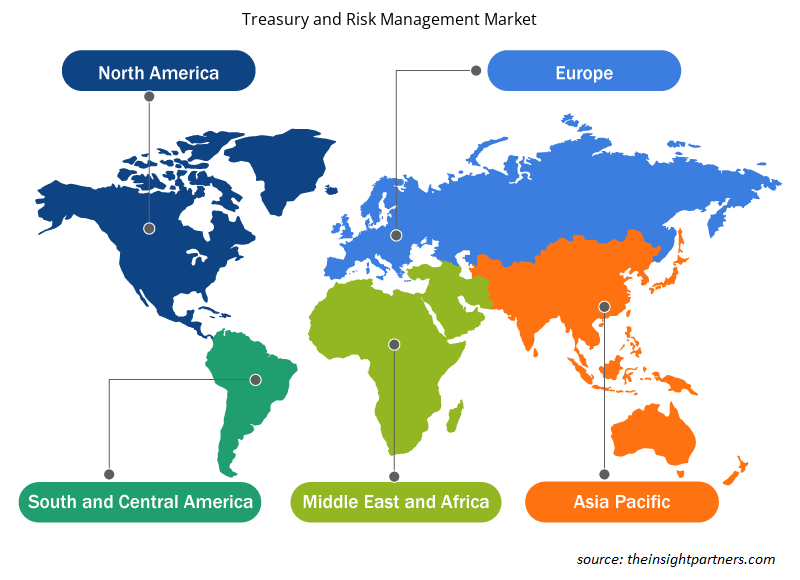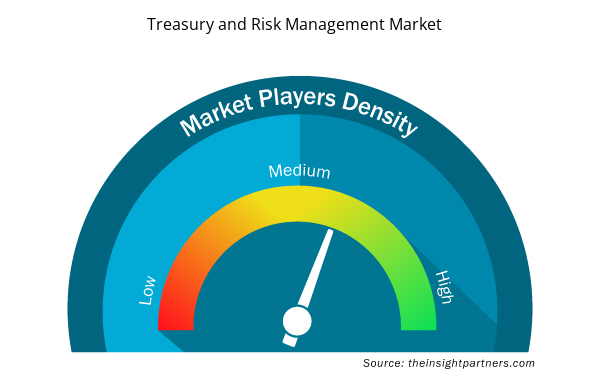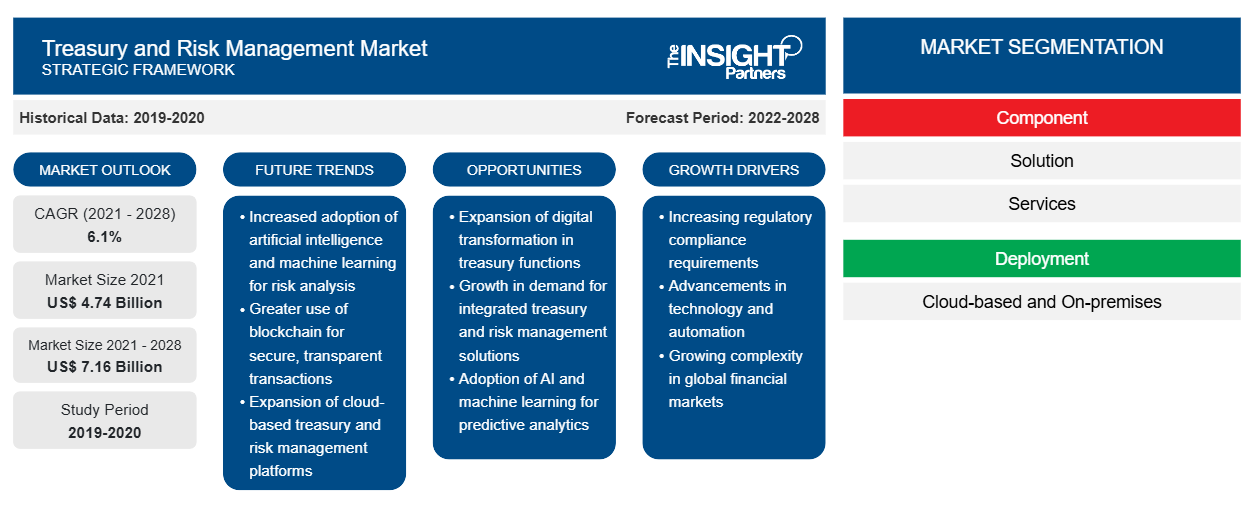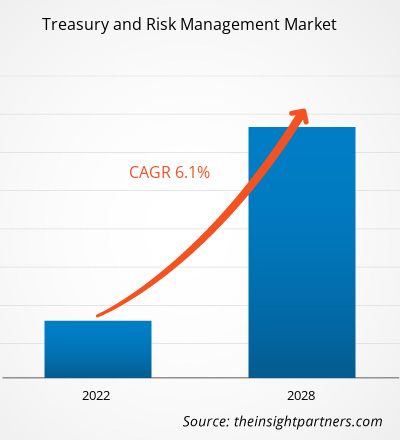预计资金和风险管理市场规模将从 2021 年的 47.3939 亿美元增长至 2028 年的 71.569 亿美元;预计 2021-2028 年期间的复合年增长率为 6.1%。
人工智能 (AI) 可帮助金融行业简化和优化各种流程,从信贷决策到财务和金融风险管理中的定量分析。AI 解决方案有助于在信贷决策过程中更准确地评估传统上服务不足的借款人(包括千禧一代),从而帮助银行和信贷贷方做出更明智的商业决策。此外,AI 还使多家银行、投资公司和财富管理公司的融资流程更加顺畅和自动化。例如,aixigo AG 使用基于 AI 的财富管理解决方案来提供数字化转型、私人银行、零售银行、机器人顾问和资产管理服务。aixigo AG 的机器人顾问软件在金融投资过程中使用 AI 取代销售点的人工组件。同样,Synechron Inc. 为金融服务行业提供了名为 Neo 的基于 AI 的解决方案。Neo 独特地结合了 Synechron 的数字、业务和技术咨询,指导金融机构部署 AI 解决方案以克服复杂的业务挑战。因此,预计在预测期内,银行、投资公司和财富管理公司对基于人工智能的援助的普及度将提高,从而推动财务和风险管理市场份额的增长。
定制此报告以满足您的需求
您可以免费定制任何报告,包括本报告的部分内容、国家级分析、Excel 数据包,以及为初创企业和大学提供优惠和折扣
- 获取此报告的关键市场趋势。这个免费样品将包括数据分析,从市场趋势到估计和预测。
COVID-19 疫情对全球财资及风险管理市场的影响
在新冠疫情爆发之前,由于数字化的不断发展,对财务和风险管理解决方案/服务的需求十分普遍。例如,根据 Business Wire 在 2019 年 4 月发表的文章,2019 年数字化转型支出为 1.18 万亿美元,比 2018 年增长了 17.9%。
根据财务和风险管理市场分析,2020 年,COVID-19 疫情显著影响了企业的运营,并改变了企业的一些基本方面。2020 年,COVID-19 疫情的蔓延导致全球多个国家实施封锁,以避免危机并将感染风险降至最低。这引发了采用数字技术的热潮,以在 COVID-19 疫情期间保持企业正常运转。大多数企业转向云基础设施,并在保持封锁限制的同时继续运营。此外,COVID-19 疫情促使企业考虑企业财务的未来,使其与数字化、综合风险管理以及重新关注成本优化和现金管理保持一致。因此,2020 年财务和风险管理解决方案/服务的采用有所增加。因此,2020 年 COVID-19 疫情对财务和风险管理市场的整体影响是积极的。
根据 2021 年和 2022 年的财务和风险管理市场分析,封锁措施的放松、多家企业采用云技术以及组织利用人工智能 (AI) 和机器学习等技术实现现金管理自动化,对财务和风险管理市场的增长产生了积极影响。例如,2021 年 5 月,Refinitiv 和 IBSFINtech 宣布合作推出一种新的基于云的自动化财务管理解决方案。名为 InTReaX 的解决方案将是一种现金和流动性以及货币风险的管理解决方案。因此,多家企业采用基于云的财务管理解决方案将为市场参与者创造多重机会。
2019 年新冠疫情爆发前的财资及风险管理市场规模为 43.3746 亿美元,2020 年疫情期间的市场规模为 45.2657 亿美元,2021 年市场规模为 47.3939 亿美元,因此,2020 年新冠疫情对市场整体影响为正。
财务和风险管理市场洞察
金融分析服务需求不断增长
组织使用财务分析工具来洞察一些当前和未来的趋势,以提高其业务绩效。财务分析服务提供财务数据质量分析、数据布局、客户分析、预测分析、主成分分析和财务数据收集。这些分析需要详细的财务和其他相关数据来识别模式。基于此分析,企业可以预测其客户的购买情况和员工的任职期。因此,财务分析服务可帮助组织提高盈利能力、现金流和业务价值。他们可以利用通过这些分析获得的见解来改善收入和业务流程。例如,埃森哲公司为金融服务提供商提供最新的数据和分析解决方案,并协助他们部署这些解决方案。财务和风险管理报告分析包括为这些公司提供成本分析和企业绩效分析服务。财务分析主要关注损益表、资产负债表和现金流量表,用于评估经济趋势、制定财务政策、制定长期业务计划以及确定投资项目或公司。由于金融是一项交易量很大的业务,因此投资银行等金融服务提供商生成和存储的数据比其他企业更多。银行使用这些数据来评估风险,以提高整体盈利能力。因此,由于银行和投资公司拥有多种优势,对金融分析服务的需求正在大幅增加,从而推动了财务和风险管理市场的增长。
财务职能部门显然受益于财务分析,财务分析可以更好地洞察客户、竞争对手、盈利能力和流程。财务分析还可以增强首席财务官 (CFO) 推动战略决策和投资规划的能力。因此,创建一个分析驱动的组织也成为 CFO 和首席信息官 (CIO) 之间协作的首要驱动力。因此,对财务分析服务的需求正在大幅增长,推动财务和风险管理市场的发展。
基于组件的市场洞察
根据组成部分,财务和风险管理市场分为解决方案和服务。2020 年,解决方案部门以较大的份额领先市场。
基于部署的市场洞察
根据部署情况,财务和风险管理市场分为基于云和本地部署。2020 年,基于云的细分市场以较大的份额领先市场。
基于企业规模的市场洞察
根据企业规模,财务和风险管理市场分为中小型企业和大型企业。2020 年,大型企业占据了较大的市场份额,引领市场。
基于应用的市场洞察
根据应用,财务和风险管理市场细分为账户管理、现金和流动性管理、合规和风险管理以及财务资源管理。现金和流动性管理部门在 2020 年占据了最大的市场份额。
基于最终用户的市场洞察
根据最终用户,市场细分为 BFSI、IT 和电信、零售和电子商务、医疗保健、制造和汽车等。BFSI 部门在 2020 年占据了财务和风险管理市场的最大份额。
财务和风险管理市场的参与者采用合并、收购和市场举措等策略来保持其在市场中的地位。以下列出了一些主要参与者的发展:
- 2021 年 7 月,FIS 推出了一系列新的人工智能 (AI) 风险解决方案。FIS 宣布与 C3 AI 合作开发了一套新产品,旨在利用其组织数据的力量帮助资本市场组织更好地管理监管合规性和风险。
- 2020 年 11 月,北欧挑战者银行 Lunar 选择了 FIS 的基于云的财务和风险管理行业解决方案,旨在获得流动性优化、风险管理和扩张方面的支持。Lunar 选择了 FIS 基于私有云的 Ambit Quantum 来简化套期保值会计和监管合规。Lunar 利用 FIS SWIFT 服务局通过 SWIFT 和其他行业交易所和网络将其财务和支付业务连接到银行合作伙伴。
财务和风险管理市场区域洞察
Insight Partners 的分析师已详尽解释了预测期内影响财务和风险管理市场的区域趋势和因素。本节还讨论了北美、欧洲、亚太地区、中东和非洲以及南美和中美洲的财务和风险管理市场细分和地理位置。

- 获取财务和风险管理市场的区域特定数据
财务和风险管理市场报告范围
| 报告属性 | 细节 |
|---|---|
| 2021 年市场规模 | 47.4亿美元 |
| 2028 年市场规模 | 71.6亿美元 |
| 全球复合年增长率(2021 - 2028) | 6.1% |
| 史料 | 2019-2020 |
| 预测期 | 2022-2028 |
| 涵盖的领域 | 按组件
|
| 覆盖地区和国家 | 北美
|
| 市场领导者和主要公司简介 |
|
市场参与者密度:了解其对商业动态的影响
财务和风险管理市场正在快速增长,这得益于最终用户需求的不断增长,而这些需求又源于消费者偏好的不断变化、技术进步以及对产品优势的认识不断提高等因素。随着需求的增加,企业正在扩大其产品范围,进行创新以满足消费者需求,并利用新兴趋势,从而进一步推动市场增长。
市场参与者密度是指在特定市场或行业内运营的企业或公司的分布情况。它表明在给定市场空间中,相对于其规模或总市场价值,有多少竞争对手(市场参与者)存在。
在财政和风险管理市场运营的主要公司有:
- Broadridge 金融解决方案公司
- 金融信息系统
- 甲骨文公司
- 普华永道国际有限公司(PWC)
- 思爱普
免责声明:上面列出的公司没有按照任何特定顺序排列。

- 获取财务和风险管理市场顶级关键参与者的概述
公司简介
- Broadridge 金融解决方案公司
- 金融信息系统
- 甲骨文公司
- 普华永道国际有限公司(PWC)
- 思爱普
- Fiserv 公司
- Calypso Technology, Inc(Adenza)
- Kyriba 公司
- 莫尔斯软件
- 威科集团
- 历史分析(2 年)、基准年、预测(7 年)及复合年增长率
- PEST 和 SWOT 分析
- 市场规模价值/数量 - 全球、区域、国家
- 行业和竞争格局
- Excel 数据集



Report Coverage
Revenue forecast, Company Analysis, Industry landscape, Growth factors, and Trends

Segment Covered
This text is related
to segments covered.

Regional Scope
North America, Europe, Asia Pacific, Middle East & Africa, South & Central America

Country Scope
This text is related
to country scope.
常见问题
Financial analytics services offer financial data quality analysis, data layout, client analytics, predictive analytics, principal component analysis, and financial data collection. These analytics require detailed financial and other relevant data to identify patterns; based on these predictions, enterprises make predictions regarding their customers purchases and their employees' tenures period.
The US held the largest market share in the Treasury and Risk Management market. The treasury and risk management market are increasing in the US due to the rise in the technological sector. As per CompTIACyberstates report, 2022 of the economic impacts of the technology sector, the direct economic impact the dollar value of goods and services produced during a given year amounts to 10.5% of US economic value, which translates to over US$ 2.0 trillion.
Based on the component type, the market is segmented into solution and services. The solution segment led the treasury and risk management market in 2021. Treasury and risk management solutions integrate tools such as payments, cash management, and bank connectivity with an extensive library of financial instruments, advanced risk analytics, and hedge accounting to provide overall visibility across the enterprise. A comprehensive risk management solution offers a holistic approach to compliance, financial, and operational risk management. Such as, Fidelity National Information Services, Inc. (FIS) offers treasury management solutions that support a digital and modernized treasury function.
FIS (Fidelity National Information Services Inc); Oracle Corporation; PricewaterhouseCoopers International Limited (PwC); SAP SE; and Fiserv, Inc. are the five key players in the Treasury and Risk Management market. These companies have shown consistent growth in revenue and larger volumes of sales. Additionally, the well-established top five players are offering a comprehensive product portfolio and have a prominent presence in terms of share in the Treasury and Risk Management market.
Based on deployment type, the treasury and risk management market are bifurcated into cloud-based and on-premises. The cloud-based segment led the treasury and risk management market in 2021. The technology sector has been increasingly witnessing a significant rise in cloud-based platforms in recent times. The cloud-based platform simplifies the deployment time and significantly reduces the cost of deployment. A few benefits of a cloud-based treasury and risk management platform are the secure hosting of critical data, improved security and scalability, and quick recovery of files. The backups are stored on a private or shared cloud host platform. Therefore, organizations can quickly recover several critical data.
Global spending on the information and communications technology (ICT) sector continues to rise. The article published by Innovation, Science and Economic Development Canada stated that over ~40,000 businesses in the Canadian ICT sector fell within the software and computer services segment in 2020. With the growing spending on the ICT sector, especially on the software/platform segment, the development and adoption of advanced technologies by businesses globally will grow in the coming years. Thus, the rising spending on the ICT sector will lead to more advanced development in the treasury and risk management systems, which will boost the demand for treasury and risk management solutions.
Trends and growth analysis reports related to Technology, Media and Telecommunications : READ MORE..
The List of Companies - Treasury and Risk Management Market
- Broadridge Financial Solutions, Inc.
- FIS
- Oracle Corporation
- Pricewaterhousecoopers International Limited (PWC)
- SAP SE
- Fiserv, Inc.
- Calypso Technology, Inc (Adenza)
- Kyriba Corp
- Mors Software
- Wolters Kluwer
The Insight Partners performs research in 4 major stages: Data Collection & Secondary Research, Primary Research, Data Analysis and Data Triangulation & Final Review.
- Data Collection and Secondary Research:
As a market research and consulting firm operating from a decade, we have published and advised several client across the globe. First step for any study will start with an assessment of currently available data and insights from existing reports. Further, historical and current market information is collected from Investor Presentations, Annual Reports, SEC Filings, etc., and other information related to company’s performance and market positioning are gathered from Paid Databases (Factiva, Hoovers, and Reuters) and various other publications available in public domain.
Several associations trade associates, technical forums, institutes, societies and organization are accessed to gain technical as well as market related insights through their publications such as research papers, blogs and press releases related to the studies are referred to get cues about the market. Further, white papers, journals, magazines, and other news articles published in last 3 years are scrutinized and analyzed to understand the current market trends.
- Primary Research:
The primarily interview analysis comprise of data obtained from industry participants interview and answers to survey questions gathered by in-house primary team.
For primary research, interviews are conducted with industry experts/CEOs/Marketing Managers/VPs/Subject Matter Experts from both demand and supply side to get a 360-degree view of the market. The primary team conducts several interviews based on the complexity of the markets to understand the various market trends and dynamics which makes research more credible and precise.
A typical research interview fulfils the following functions:
- Provides first-hand information on the market size, market trends, growth trends, competitive landscape, and outlook
- Validates and strengthens in-house secondary research findings
- Develops the analysis team’s expertise and market understanding
Primary research involves email interactions and telephone interviews for each market, category, segment, and sub-segment across geographies. The participants who typically take part in such a process include, but are not limited to:
- Industry participants: VPs, business development managers, market intelligence managers and national sales managers
- Outside experts: Valuation experts, research analysts and key opinion leaders specializing in the electronics and semiconductor industry.
Below is the breakup of our primary respondents by company, designation, and region:

Once we receive the confirmation from primary research sources or primary respondents, we finalize the base year market estimation and forecast the data as per the macroeconomic and microeconomic factors assessed during data collection.
- Data Analysis:
Once data is validated through both secondary as well as primary respondents, we finalize the market estimations by hypothesis formulation and factor analysis at regional and country level.
- Macro-Economic Factor Analysis:
We analyse macroeconomic indicators such the gross domestic product (GDP), increase in the demand for goods and services across industries, technological advancement, regional economic growth, governmental policies, the influence of COVID-19, PEST analysis, and other aspects. This analysis aids in setting benchmarks for various nations/regions and approximating market splits. Additionally, the general trend of the aforementioned components aid in determining the market's development possibilities.
- Country Level Data:
Various factors that are especially aligned to the country are taken into account to determine the market size for a certain area and country, including the presence of vendors, such as headquarters and offices, the country's GDP, demand patterns, and industry growth. To comprehend the market dynamics for the nation, a number of growth variables, inhibitors, application areas, and current market trends are researched. The aforementioned elements aid in determining the country's overall market's growth potential.
- Company Profile:
The “Table of Contents” is formulated by listing and analyzing more than 25 - 30 companies operating in the market ecosystem across geographies. However, we profile only 10 companies as a standard practice in our syndicate reports. These 10 companies comprise leading, emerging, and regional players. Nonetheless, our analysis is not restricted to the 10 listed companies, we also analyze other companies present in the market to develop a holistic view and understand the prevailing trends. The “Company Profiles” section in the report covers key facts, business description, products & services, financial information, SWOT analysis, and key developments. The financial information presented is extracted from the annual reports and official documents of the publicly listed companies. Upon collecting the information for the sections of respective companies, we verify them via various primary sources and then compile the data in respective company profiles. The company level information helps us in deriving the base number as well as in forecasting the market size.
- Developing Base Number:
Aggregation of sales statistics (2020-2022) and macro-economic factor, and other secondary and primary research insights are utilized to arrive at base number and related market shares for 2022. The data gaps are identified in this step and relevant market data is analyzed, collected from paid primary interviews or databases. On finalizing the base year market size, forecasts are developed on the basis of macro-economic, industry and market growth factors and company level analysis.
- Data Triangulation and Final Review:
The market findings and base year market size calculations are validated from supply as well as demand side. Demand side validations are based on macro-economic factor analysis and benchmarks for respective regions and countries. In case of supply side validations, revenues of major companies are estimated (in case not available) based on industry benchmark, approximate number of employees, product portfolio, and primary interviews revenues are gathered. Further revenue from target product/service segment is assessed to avoid overshooting of market statistics. In case of heavy deviations between supply and demand side values, all thes steps are repeated to achieve synchronization.
We follow an iterative model, wherein we share our research findings with Subject Matter Experts (SME’s) and Key Opinion Leaders (KOLs) until consensus view of the market is not formulated – this model negates any drastic deviation in the opinions of experts. Only validated and universally acceptable research findings are quoted in our reports.
We have important check points that we use to validate our research findings – which we call – data triangulation, where we validate the information, we generate from secondary sources with primary interviews and then we re-validate with our internal data bases and Subject matter experts. This comprehensive model enables us to deliver high quality, reliable data in shortest possible time.


 获取此报告的免费样本
获取此报告的免费样本